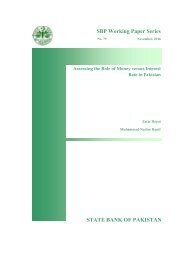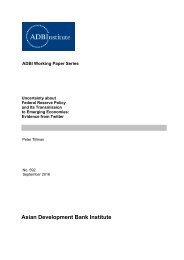SBP Working Paper Series STATE BANK OF PAKISTAN
n?u=RePEc:sbp:wpaper:74&r=mon
n?u=RePEc:sbp:wpaper:74&r=mon
Create successful ePaper yourself
Turn your PDF publications into a flip-book with our unique Google optimized e-Paper software.
3.1 Firms<br />
3.1.1 Final Good Producing Firms<br />
The final good producing firms produce final good for consumption and investment by combining the<br />
differentiated goods produced by intermediate good producers according to the following Dixit-Stiglitz<br />
bundling technology:<br />
<br />
p<br />
<br />
p<br />
1<br />
1<br />
p <br />
1<br />
=<br />
j<br />
<br />
p<br />
y ( )<br />
<br />
t<br />
<br />
yt<br />
dj<br />
(2)<br />
0 <br />
<br />
<br />
j<br />
th<br />
Here y<br />
t<br />
, yt<br />
and <br />
p<br />
represent intermediate good produce by j intermediate firm, final output and<br />
constant elasticity of substitution between intermediate products, respectively. For given price and<br />
j<br />
elasticity of substitution, the final good producers choose the quantity y<br />
t<br />
of each intermediate good in<br />
such a way that maximizes their profit. The result of this profit maximization is the following demand<br />
th<br />
function for the j intermediate good:<br />
y<br />
j<br />
t<br />
<br />
p<br />
j<br />
P <br />
t<br />
= yt<br />
(3)<br />
Pt<br />
<br />
The equation (3) shows that the demand for intermediate good j is inversely related to its relative price<br />
and directly related to aggregate output. Aggregating across all intermediate goods and using equation (2),<br />
we get the aggregate price level<br />
P<br />
t<br />
j 1 p <br />
p<br />
P<br />
dj1<br />
1<br />
t<br />
<br />
1<br />
= <br />
(4)<br />
0 <br />
3.1.2 Intermediate Good Producing Firms<br />
Intermediate goods producers demand capital and labour for given wages and rental rate of capital in<br />
competitive factors market. In addition, they set price of their differentiated product while exploiting<br />
some degree of monopoly and considering uncertainty regarding their ability to change prices in future.<br />
The Calvo (1983) model is used to capture the intermediate good producing firms’ behavior under this<br />
uncertainty.<br />
Demand for Labour and Capital<br />
The intermediate good producing firms are assumed to follow a Cobb-Douglas production function with<br />
constant returns to scale (CRS)<br />
j<br />
j<br />
k h<br />
1<br />
j<br />
y = exp( a )<br />
(5)<br />
t<br />
where<br />
way.<br />
t<br />
t<br />
a<br />
t<br />
t1<br />
t<br />
a = a <br />
is a stochastic technology shock that affects all intermediate firms in the same<br />
a<br />
a<br />
t<br />
a<br />
a<br />
is the persistence parameter and <br />
t<br />
~ N(0,<br />
) is an i.i.d. random shock to total factor<br />
productivity (TFP). The parameter is the share of capital in production. Also,<br />
capital and labour utilized by firm j respectively.<br />
j<br />
kt<br />
and<br />
j<br />
ht<br />
are physical<br />
13






